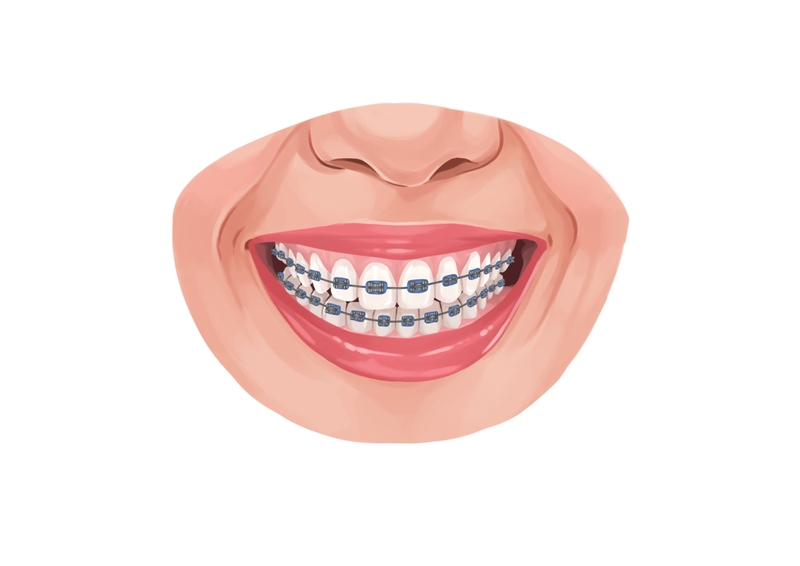- Headgear is a dental appliance used to correct misaligned teeth. It is necessary when braces alone cannot correct malocclusion.
- To achieve the effect of the treatment, you need to wear the appliance 12 hours a day, including bedtime. You can take them out to eat and drink.
- You may experience pain and discomfort when using the braces for the first time.
Need affordable dental care? Use Authority Dental to find a dentist near you.
Do you need headgear braces for your misaligned teeth? Here's everything you need to know.
Basic parts of headgear

Picture by Authority Dental under CC 2.0 license
There are several parts used in headgear, depending on what type of headgear is used and what condition it is being used to correct.
Head cap
This piece rests on your head and acts as an anchor for the rest of the pieces.
Fitting straps
There are several types of fitting straps based on the type of headgear. For instance, high-pull headgear utilizes several straps that wrap around the back of the head. Cervical headgear just has one strap that attaches the head cap and extends down the back of the neck.
Elastic bands
These anchor the parts of the headgear to the teeth.
Facebow
This piece is U-shaped that attaches to the teeth, head cap, and straps.
Chin cup / forehead pad / mouth yoke
These pieces are used to correct and underbite. The chin cup attaches to the forehead pad and is used to anchor the appliance. In this situation, a head cap would not be necessary.
Braces
Sometimes the headgear is attached to braces on the teeth to help with the correction process.
When is headgear necessary?
Headgear is only necessary when any form of malocclusion cannot be correct with braces alone. Headgear proves a solid anchor for more serious movement of the teeth. One of the most common reasons to need headgear is when the posterior teeth need to be moved forward.
Orthodontic headgear types
There are three types of headgear. The one used depends on what condition needs to be changed.
Cervical pull
Cervical pull headgear is used to treat an overbite. An overbite occurs when the maxillary anterior teeth overlap the mandibular anterior teeth. A small overbite is healthy, but the maxillary teeth should only overlap the mandibular teeth by about a third of the length of the teeth. A cervical pull headgear keeps the upper jaw in place and shifts the lower jaw forward.
A cervical pull headgear appliance has a U-shaped wire that attaches to bands that are placed on the molars to a strap that wraps around the back of the neck.
High pull
High pull headgear is also used to treat an overbite. The appliance is very similar to the cervical pull option, but instead of the strap going behind the neck, it is placed behind the head.
Reverse pull (facemask)
A reverse pull headgear appliance, also referred to as facemask headgear, is used to correct an underbite. It works by gently pulling the upper jaw forward until it is correctly aligned with the lower jaw.
A reverse pull appliance uses a forehead pad and chin cup and attaches the two to a vertical frame. The frame is connected to braces on the teeth by elastics or wires.
Dos and don'ts while wearing headgear
There are a few things you’ll need to know if you have headgear. Your orthodontist will give you specific instructions for your case, but there are some dos and don'ts that apply to everyone.
Wearing the appliance
In most cases, you will need to wear the headgear for 12 hours each day. Most people prefer to wear it while sleeping and then for a few hours either before or after bed. If you miss one night, you must make up the lost time the following day. Not doing this can cause you to start over at square one! It is common to use headgear for 1-2 years.
Eating and drinking with your appliance
You will not be able to eat or drink when your appliance is on, which is why most people choose to wear it when sleeping. You’ll also need to take it out when you brush and floss your teeth.
Sleeping with your appliance
It may be difficult to adjust to sleeping while wearing your appliance. It is recommended that you sleep on your back and find a comfortable pillow that complements your headgear.
Orthodontic headgear side effects
Like other forms of orthodontics, there will likely be some soreness and discomfort when you first start wearing headgear. Your orthodontist will recommend over-the-counter pain medications and a softer diet for the first week or two. After that, your soreness should dissipate.
Otherwise, there are no side effects associated with headgear. If you experience pain, call your orthodontist.
FAQ
How much does headgear cost?
Does headgear hurt?
How long do you have to wear headgear?
How to clean headgear?
Are there any alternatives to headgear braces?